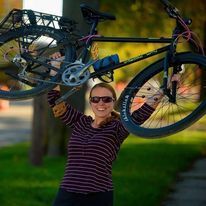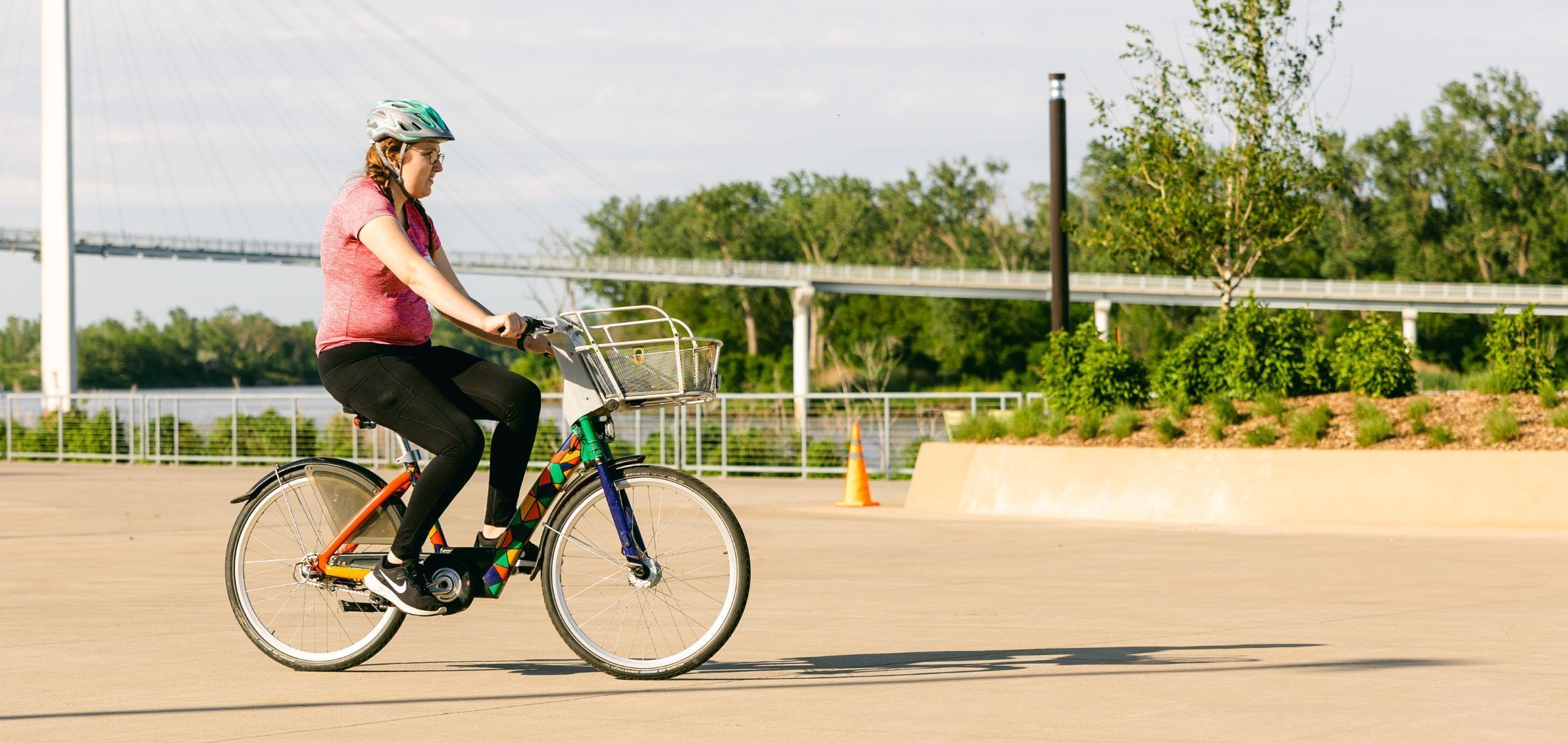
Today's blog is courtesy of guest author Sarah Knight from Lincoln. Sarah is a bicycle commuter and a devotee of gravel road riding on her fat bike. She also has an adorable cat.
If you ride a bike, you've heard it countless times from well-meaning friends, relatives, co-workers. Sometimes it comes with a worried sigh. Sometimes it's a firm admonishment. But the phrase is always the same:
"Be safe!"
I know that it almost always comes from a place of concern, but I can never help being slightly annoyed by the phrase itself. Implied at the beginning of that sentence is a "you": YOU be safe – as though I wouldn't be otherwise. YOU protect yourself – as if I weren't already doing all that I can. YOU watch out – as though I can ever forget the danger I face.
As I was riding home today, I took a mental inventory of the behaviors I practice to keep myself safe:
- Running front and rear lights, day and night, with different modes and flash patterns designed for both daytime and nighttime visibility.
- Changing to studded tires in the winter to avoid slipping.
- Favoring brighter clothing, jackets, shoes, etc.
- Wearing anything I can find that is reflective.
- Dressing to avoid getting too hot.
- Dressing to avoid getting too cold. (Sometimes this involves carrying multiple jackets and pairs of gloves.)
- Adding highly reflective 3M tape to wheels, crankarms, helmet.
- Wearing a ROAD ID on my watch permanently, in case I'm ever injured badly enough not to be able to give my name or emergency contact numbers.
- Upgrading to a new enough Apple Watch to be able to turn on Fall Detection to call emergency services and text my emergency contacts in case I'm ever unresponsive.
- Not only always wearing a helmet, but also making a point of finding and paying extra for helmets with concussion-protection technologies like MIPS – and getting a new helmet every several years or whenever one takes a hit, whichever happens first.
- Developing an intimate knowledge of the nuances of local crosswalk ordinances. (tl;dr: You don't have the right of way in a signalized crosswalk unless you start crossing with the walk signal.)
- Always telling someone when I'm riding and where I'm riding to, and letting them know when I return.
- Sharing my location via GPS with whoever is watching out for me.
- ...But also setting up privacy zones and settings and varying my routes enough that I'm not too predictable if someone else is after me or my bike.
- Sticking to trails and quiet residential streets for my routes whenever possible.
- Signaling my every move to anyone (drivers, people walking, etc.) who might be impacted by my movements.
- Riding in a way that is visible and predictable, following the rules of the road or trail.
- Watching vehicles' wheels for signs of turning and stopping. (Pro tip: Never trust eye contact or turn signals.)
- Waiting for large gaps in traffic before I cross a road without a traffic signal.
- Watching for potholes – and reporting them for repair on the city's app when I get home.
- Watching for loose dogs – even in town. Discussing best tactics for handling dog chases with friends who ride.
- Watching for drivers who run red lights at intersections.
- Watching for drivers who turn right on red without looking (or even stopping).
- Watching for drivers who turn left without looking.
- Watching for drivers who back out of driveways or parking spots without looking.
- Watching for drivers who drive in bike lanes, either deliberately or by drifting.
- Watching for drunk / impaired / distracted drivers.
- Watching for drivers who do not leave sufficient passing clearance.
- Watching for road-raging drivers.
- Being mindful of the potential movements of any vehicle that could possibly cross my path, and expecting the unexpected from them. This includes watching for gaps in traffic that a driver might seize to suddenly turn in front of me.
- Being aware of situations in which a driver might not see me.
If you ride (or walk, or run) enough, if you pay attention to safety, you will start to notice the myriad ways in which your built environment, your community, and your culture fail to consider the safety of people who dare to move around outside of a car. Speed limits reach numbers that are increasingly likely to kill and maim people who are hit by cars – and speeding above those limits is generally overlooked. Trucks' and SUVs' front ends get taller and bigger and flatter every year, doing more damage to bodies as people are no longer able to roll up onto a hood or windshield in a collision. Trails and bike lanes are often not where you need them to be for transportation – and sometimes your city learns through close calls or crashes that the design could use improvement.
I don't need to be reminded to be safe. I am safe. All of the practices I do above are second nature to me by now. I am confident but cautious; assertive, but also courteous enough to do small kindnesses for everyone else on the road whenever I can. I am a frequent user of the friendly "thank-you" wave, and my favorite little trick when I'm first in line at a red light in a wide enough lane is to scoot to the left enough to let a driver behind me complete a right turn.
If you want me to make it to my destination safely, I need help beyond what I can do. I need drivers to watch. I need law enforcement to be trained on the laws that affect people riding bikes. I need safe, well-marked and well-designed streets and trails to ride on. I want us all to consider the danger we face on the roads, to be aware of each other, and do everything we can for our collective safety.
Oh – and if you want a good wish without this baggage? How about "Have a good ride!"?

